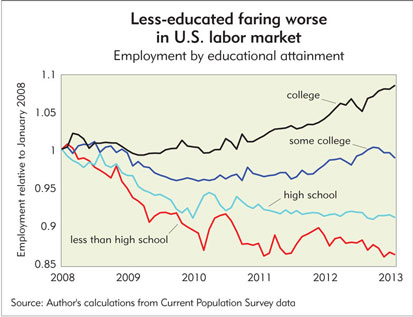
Erzo Luttmer
During the Great Recession, cautious households spent less and saved more as unemployment rose. The U.S. economy is still trying to recover. But rising unemployment didn’t affect everyone equally. Gender, racial and age gaps were large, but variation by educational attainment was also dramatic. Those with less education suffered far higher unemployment rates than those with advanced degrees. Moreover, this disparity was apparent in all sectors of the economy, not only in those most depressed by the downturn in spending.
Unfortunately, standard models of employment fluctuations are unable to explain this pattern. Some models focus on labor reallocation in response to economic surprises in specific sectors; they suggest that because recessions often hit some sectors harder than others, consumer demand and therefore workers will shift among sectors as a recession proceeds. Other models predict that in recessions triggered by a decline in consumer wealth, employment should rise as consumers work more to rebuild their wealth.
This clearly wasn’t the case in the 2008-09 Great Recession, when unemployment reached levels rarely seen in the United States. The unemployment rate has declined steadily if slowly since its 2009 peak, but just 58 percent of the civilian adult population had jobs at the Recession’s end, and this unusually low employment-population ratio—down from 63 percent pre-Recession—persists today.
A model that works
In a Minneapolis Fed working paper, “The Stolper-Samuelson Effects of a Decline in Aggregate Consumption” (Working Paper 703), Fed consultant Erzo G. J. Luttmer develops a theory that is able to account analytically for U.S. consumption and employment patterns experienced during the Great Recession. At its core is the intuitive notion that people have different types of skills, and how much those skills are valued by markets will vary as economies cycle through booms and recessions.
Luttmer begins his paper at an even deeper level: people’s expectations about their economic future. “Consider an economy,” he writes, in which consumers believe their income will rise significantly at some future date. “But they cannot suppress the nagging feeling that... [this also might] never happen.” They also know that if rising income isn’t in their cards, they’ll eventually receive a signal to that effect.
Under these conditions, Luttmer observes, “a long period without a negative signal will make consumers believe, with a very high degree of confidence, that they will eventually receive the rise in income. They consume accordingly.”
Put less formally: If people are quite certain they’ll make lots of money in the future, and no one suggests otherwise, they’ll spend like there’s no tomorrow.
Luttmer then asks: “When an economy has been in this [optimistic] state for some time, what exactly will happen if the negative signal does eventually arrive?” To provide the answer, he studies what happens when tomorrow does arrive in his model, just as U.S. real estate and financial markets suddenly collapsed in 2007 and 2008, to widespread surprise, after a prolonged boom.
Division of labor
Luttmer’s paper builds on different foundations than standard models and provides “an analytic exposition of the effect of sudden belief revisions on job creation and destruction.” In his model, jobs are a form of capital, and not all employees are capable of creating them. Some employees, termed “workers,” provide only the labor needed to produce consumption goods; others can supervise workers who produce consumption goods or develop the new projects that generate new jobs—Luttmer refers to them as “managers.” Thus, managers can team up with workers to produce consumption goods, or they can focus on developing new projects without the help of workers. This division of labor, so to speak, drives his results.
When the economy is doing well and people are spending on consumption goods, worker wages rise relative to managerial wages. This is the Stolper-Samuelson theorem. Briefly stated, it holds that as the price of a given product rises, the prices of inputs used intensively to produce the product will also rise. Conversely, if a good or service experiences a decline in market value, inputs used intensively to create it will be paid less.1
So, in Luttmer’s model, consumers optimistic about the future will borrow more, thereby raising interest rates; that, in turn, lowers the value of new projects, and their prices fall relative to consumption goods. Wages will rise for workers since they’re used intensively in producing (highly valued) consumption goods.
When bubbles burst
But if and when beliefs change—the negative income signal arrives—and consumer spending declines, consumption goods sit on shelves, consumers borrow less and interest rates decline. Workers—the type of employees used intensively in consumer goods production—are laid off.
Not all employees are affected equally, however. Low interest rates make investment in new projects more profitable. Because only managers (not workers) can develop new projects, they’ll be highly prized. Their wages will rise while those for workers decline. This, again, is Stolper-Samuelson: New projects are more highly valued, so the inputs used intensively in their creation (managers), will be paid more.
Finding jobs that pay well becomes increasingly difficult for workers, and the resulting decline in worker employment drives down overall employment. Investors would like to hire more managers and are willing to pay higher wages, but the supply of managers can’t increase quickly over a single business cycle in response.
Luttmer offers what he calls “suggestive evidence” in support of this theory: data on employment trends by educational level. During the Recession, he notes, “unemployment among employees without a high school degree rose from about 8 percent to as much as 16 percent, while for college graduates the rise was from 2 percent to only about 4.5 percent.” A graph of employment levels by education from 2008 to early 2013 in relation to their January 2008 levels shows that for the college educated, employment barely changed, but those without a high school diploma suffered a 10 percent job decline.
“These patterns are precisely what the model in this paper predicts,” he writes. One employee type—managers—has a skill with higher value given current product prices. A recession presents an opportunity for new project creation, so managerial skills are treasured. Since less-educated employees tend to be workers rather than managers, they are likely to suffer more job losses when a recession lowers spending on the consumption goods they produce.
Luttmer notes that his model’s belief shocks have to affect everyone more or less simultaneously—both the optimism and its collapse. “Viewed from this perspective, it could be that an important aspect of the U.S. financial crisis of the fall of 2008 was that it triggered a highly coordinated realization that previously held beliefs about aggregate wealth were too optimistic.”
All bubbles burst, often in one jarring implosion. But fallout scatters unevenly.
Endnote
1 This theorem from international trade economics explains how domestic input prices of labor and capital are affected by changes in world prices of different types of output.






